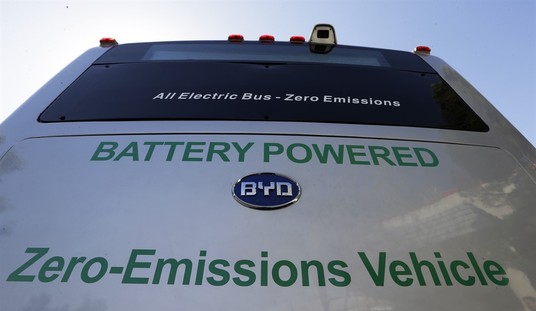National debt? Eh … who’s counting? CBS’ Mark Knoller, for one, and by his calculation, Barack Obama has just passed a milestone — at lightning speed:
The National Debt has now increased more during President Obama’s three years and two months in office than it did during 8 years of the George W. Bush presidency.
The Debt rose $4.899 trillion during the two terms of the Bush presidency. It has now gone up $4.939 trillion since President Obama took office.
The latest posting from the Bureau of Public Debt at the Treasury Department shows the National Debt now stands at $15.566 trillion. It was $10.626 trillion on President Bush’s last day in office, which coincided with President Obama’s first day.
The National Debt also now exceeds 100% of the nation’s Gross Domestic Product, the total value of goods and services.
It doesn’t get any better, either. Obama has proposed a new budget for FY2013 that will add another $900 billion to the national debt under the most cheery, best-case scenarios imaginable, and likely will exceed the trillion-dollar mark for the fifth time in his presidency. In the budget projections released with that proposal, Knoller points out that Obama expects to leave office with a national debt of $20 trillion — which will mean that Obama himself would have nearly doubled the debt during his eight years in office, adding $9.34 trillion for an increase of 87%.
Of course, the proper way to calculate debt responsibility is by control of Congress. As I pointed out eighteen months ago, that’s actually worse for Democrats:
First, let’s break down the last 10 years of the Bush/Obama era by control of Congress, starting on January 1, 2001. The starting point for the national debt was $5.662 trillion. On January 6, 2007, when Democrats took over, Republicans in total control had added $3.011 trillion in debt in six years, just slightly less than Obama has added since taking office less than two years ago. Since taking control of Congress less than four years ago, Democrats have added $4.992 trillionto the national debt.
Perhaps it would be more fair to look at the entirety of Republican control of the House, which lasted 12 years and bridged the Clinton and Bush administrations. In that entire span, Republican budgets added $3.873 trillion to the national debt. That is not only far below what Democrats have added in just one-third of the time, it’s also far below the Obama administration’s own projections of how much they will add to the national debt in just one term.
We can also do the same calculations by fiscal year, from October 1 to September 30 each year, matching the budgets. Using that guide, we find the following scenarios:
- Republicans in control for 12 years: Added $4.034 trillion (avg $336.17 billion per year)
- Republicans in control during Bush era: Added $3.201 trillion (avg $533.5 billion per year)
- Democrats in control of Congress during Bush/Obama era: Added $4.603 trillion (avg 1.48 trillion per year)
The solution for out-of-control deficit spending will have to come from Congress, since this President consistently refuses to take responsibility for it. Guy Benson has an in-depth rundown of Rep. Paul Ryan’s new budget, which at least takes a large step in the right direction:
On Spending – The Path to Prosperity spends $3.53 Trillion in FY 2013, a number that grows to $4.88 Trillion by the end of the decade. It restores full military funding to pre-Budget Control Act sequestration levels, off-setting those dollars elsewhere and preventing a harmful gutting of our national defense. It reduces spending by $5 Trillion over the next ten years, compared to Obama’s budget. It restores federal spending to the historical norm of 20 percent of GDP by 2015.
On Deficits – Ryan’s blueprint reduces budget deficits by $3 Trillion over the coming decade, relative to Obama’s budget. Although it doesn’t happen immediately, and unlike Obama’s plan, this budget balances. Within the current decade window, it comes closest to primary balance by achieving a $166 Billion annual deficit in 2018 (to put that into perspective, 2010’s deficit under this president was $1.6 Trillion). The closest Obama’s budget comes to primary balance is a $617 Billion shortfall in 2017, which is still roughly double the size of President Bush’s average deficit.
On Debt – Unlike President Obama’s unflinching debt express, the GOP budget’s lowers spending and enacts crucial reforms to chart a more sustainable debt course, allowing the United States to gradually begin paying down the national debt. The plan would retire the publicly-held debt by the 2050’s. Gross debt reached 100 percent of US GDP this year, an alarming tipping point — yet President Obama’s new budget offers ever higher debt in perpetuity[.]
Be sure to read it all. Ryan’s plan takes the right approach, but doesn’t go far enough. It’s not sufficient any longer to slow the rate at which we add to the national debt; we have to start subtracting from it. Now that we have reached the Greece threshold of debt at 100% of our GDP, we can’t afford to keep adding to it. Unfortunately for Ryan — who certainly understands the problem — he doesn’t have enough people in Washington that will show the necessary leadership to get that kind of approached passed and signed into law. Until voters get serious and toss Obama and other unserious spenders out of office, Ryan can’t do any better than incremental improvements, which I’ll take over the alternatives offered at the moment.
Update: Don’t miss Steve Eggleston’s analysis in our Green Room, either. He was ahead of CBS by three days.








Join the conversation as a VIP Member